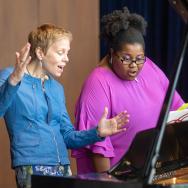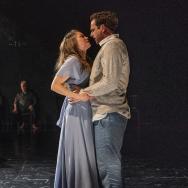Scientists stage experiments all the time—but only a few stage plays. But at the University of Chicago, an innovative art/science lab embedded in its Pritzker School of Molecular Engineering has found inspiration in a unique place: the scientific process.
“We use research, brainstorming and improvisation to generate and investigate new ideas, with continuous analysis and feedback,” said Prof. Nancy Kawalek, the director, actor and writer who heads STAGE (Scientists, Technologists and Artists Generating Exploration).
But these are not science lectures disguised as plays, she said: “By creating emotionally engaging stories, we get the public interested in and excited about science.”
STAGE is based at the PME, the first school in the nation dedicated to defining molecular engineering—an emerging field that builds on advances in basic science to design technology from the molecular level up. In turn, Kawalek works with scholars, students, scientists and artists from across the University, as well as externally, to also use technology as an integral part of staging stories about science.
The STAGE lab group is comprised of scientists and artists who collaboratively develop new theater work through a unique process of improvisation and iteration. Each theater project centers on a scientific concept, which is integrated over months of rehearsals into a story that has an emotional parallel to the scientific topic. For example, the lab’s latest project melds quantum entanglement and kung fu.
The project was inspired when Kawalek became aware of a museum exhibit by new media artist Jeffrey Shaw. The exhibit, Kung Fu Motion, used motion capture and other technology to map a young kung fu master’s moves onto a lifelike avatar of his long-deceased great-grandfather, the revered Master Lam Sai Wing.
“In this way, the singular style of kung fu originated by Lam Sai Wing, and in some sense the master himself, were brought back to life on film,” Kawalek said. “Though still in the very early stages, Entanglement is evolving into a play about science, technology, memory and heritage. Quantum entanglement takes us into the remarkable future of technology, while the intangible cultural heritage of kung fu offers inextricable links to the past.”
Kawalek was fascinated by the museum exhibit, especially after learning that the words “kung fu” carry, among other things, the connotation of energy and time. Additional links emerged through discussions with Tian Zhong, a PME assistant professor and STAGE collaborator, who has been doing research on a quantum phenomenon called time-energy entanglement.
Zhong said the exhibit is a powerful demonstration of the type of connections STAGE wants to draw. “The avatar represents a collapsing of time, spanning two generations through movement. This is exactly the essence of time-energy entanglement, so we thought this was a perfect way to inform an audience about the concepts of quantum physics,” he said.
This past summer, the STAGE group worked with The Hong Kong Jockey Club University of Chicago Academic Complex | The University of Chicago Francis and Rose Yuen Campus to travel to Hong Kong to research kung fu and quantum science. Hosted by Shaw's lab in the City University of Hong Kong School of Creative Media, students and faculty met with Shaw as well as Master Oscar Lam, Lam Sai Wing’s great-grandson, and Hing Chao, a leading advocate for the preservation of Chinese martial arts.
Throughout the Hong Kong workshop, research, kung fu lessons, and brainstorming and motion capture sessions provided compelling material for developing Entanglement, Kawalek said. For example, Zhong and the STAGE group had a fruitful discussion with Chao about the role of energy in martial arts. When Zhong raised questions about scientific concepts like conservation, Chao offered an impromptu demonstration of forces specific to different martial arts, such as the linear punches of boxing, versus the arcing shapes of many methods of attack in other types of Chinese martial arts.
As the play develops, Zhong said, he hopes it will increase public awareness and knowledge about quantum science, especially among younger generations. “Some of the concepts in quantum physics are very counterintuitive, and it’s a struggle to relate them to our everyday experiences,” he said. “But I believe earlier and greater exposure to ‘bizarre’ concepts such as these will generate many more innovative ideas down the road.”
STAGE continues to investigate the ideas discovered during their Hong Kong research trip, and Kawalek said the lab hopes to present a workshop production in 2020.
As with all STAGE lab projects, Kawalek said, the goal of Entanglement is to excite the public about science and technology through theater that is relevant to our lives, which are influenced by technological and scientific advances at every turn.
“These connections between science and art—at some level, they’re about the same thing,” Zhong said. “Both start with asking intriguing questions. Then you use existing knowledge to inquire and explore, and the outcome is creation—new knowledge or new art. It’s just the toolsets that are different.”
The workshop was supported by The Hong Kong Jockey Club University of Chicago Academic Complex | The University of Chicago Francis and Rose Yuen Campus, the Croucher Foundation, the Chinese University of Hong Kong, the School of Creative Media, City University of Hong Kong, and the National Science Foundation. Organizational assistance was provided by the International Guoshu Association, of which Chao is the founder and executive director.

